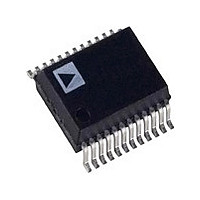ADE7755ARS Analog Devices Inc, ADE7755ARS Datasheet - Page 16

ADE7755ARS
Manufacturer Part Number
ADE7755ARS
Description
IC ENERGY METERING 24-SSOP
Manufacturer
Analog Devices Inc
Datasheet
1.ADE7755ARSZRL.pdf
(20 pages)
Specifications of ADE7755ARS
Rohs Status
RoHS non-compliant
Input Impedance
390 KOhm
Measurement Error
0.1%
Voltage - I/o High
2.4V
Voltage - I/o Low
0.8V
Current - Supply
3mA
Voltage - Supply
4.75 V ~ 5.25 V
Operating Temperature
-40°C ~ 85°C
Mounting Type
Surface Mount
Package / Case
24-SSOP (0.200", 5.30mm Width)
Meter Type
Single Phase
For Use With
EVAL-ADE7755ZEB - BOARD EVALUATION FOR AD7755
Lead Free Status / RoHS Status
Not Compliant
Available stocks
Company
Part Number
Manufacturer
Quantity
Price
Part Number:
ADE7755ARS
Manufacturer:
ADI/亚德诺
Quantity:
20 000
Company:
Part Number:
ADE7755ARS/ADE7755
Manufacturer:
Panasonic
Quantity:
200
Part Number:
ADE7755ARSRL
Manufacturer:
ADI/亚德诺
Quantity:
20 000
Part Number:
ADE7755ARSZ
Manufacturer:
ADI/亚德诺
Quantity:
20 000
Company:
Part Number:
ADE7755ARSZ-RL
Manufacturer:
TI
Quantity:
230
Company:
Part Number:
ADE7755ARSZRL
Manufacturer:
FREESCALE
Quantity:
430
ADE7755
As can be seen in Figure 32, the frequency output CF varies over
time, even under steady load conditions. This frequency variation
is primarily due to the cos(2 ωt) component in the instantaneous
active power signal. The output frequency on CF can be up to
2048 times higher than the frequency on F1 and F2. This higher
output frequency is generated by accumulating the instantaneous
active power signal over a much shorter time while converting
it to a frequency. This shorter accumulation period means less
averaging of the cos(2 ωt) component. Consequently, some of
this instantaneous power signal passes through the digital-to-
frequency conversion, which is not a problem in the
application. When CF is used for calibration purposes, the
frequency should be averaged by the frequency counter. This
averaging operation removes any ripple. If CF is measuring
energy, for example, in a microprocessor-based application, the
CF output should also be averaged to calculate power. Because
the outputs, F1 and F2, operate at a much lower frequency,
more averaging of the instantaneous active power signal is
carried out. The result is a greatly attenuated sinusoidal content
and a virtually ripple-free frequency output.
INTERFACING THE ADE7755 TO A
MICROCONTROLLER FOR ENERGY MEASUREMENT
The easiest way to interface the ADE7755 to a microcontroller
is to use the CF high frequency output with the output frequency
scaling set to 2048 × F1, F2. This is done by setting SCF = 0 and
S0 = S1 = 1 (see Table 8). With full-scale ac signals on the analog
inputs, the output frequency on CF is approximately 5.5 kHz.
Figure 33 illustrates one scheme that can be used to digitize the
output frequency and carry out the necessary averaging described
in the Digital-to-Frequency Conversion section.
MULTIPLIER
INSTANTANEOUS ACTIVE POWER SIGNAL
V × I
2
0
(FREQUENCY DOMAIN)
V
I
Figure 32. Active Power-to-Frequency Conversion
LPF TO EXTRACT
REAL POWER
(DC TERM)
ATTENUATED BY LPF
ω
LPF
FREQUENCY (RAD/s)
cos(2ωt)
2ω
FREQUENCY
FREQUENCY
DIGITAL-TO-
DIGITAL-TO-
F1
F2
CF
f
F1
OUT
TIME
TIME
Rev. A | Page 16 of 20
As shown in Figure 33, the frequency output CF is connected to
an MCU counter or port, which counts the number of pulses in
a given integration time that is determined by an MCU internal
timer. The average power proportional to the average frequency
is given by
The energy consumed during an integration period is given by
For the purpose of calibration, this integration time can be
10 seconds to 20 seconds to accumulate enough pulses to ensure
correct averaging of the frequency. In normal operation, the
integration time can be reduced to 1 second or 2 seconds
depending, for example, on the required update rate of a display.
With shorter integration times on the MCU, the amount of
energy in each update may still have some small amount of
ripple, even under steady load conditions. However, over a
minute or more, the measured energy has no ripple.
POWER MEASUREMENT CONSIDERATIONS
Calculating and displaying power information always has some
associated ripple that depends on the integration period used in
the MCU to determine average power and also the load. For
example, at light loads, the output frequency can be 10 Hz. With
an integration period of 2 seconds, only about 20 pulses are
counted. The possibility of missing one pulse always exists because
the ADE7755 output frequency is running asynchronously to the
MCU timer. This possibility results in a 1-in-20 (or 5%) error in
the power measurement.
FREQUENCY
Average
Energy
1
DIRECTION OF ENERGY FLOW IS NEEDED
AVERAGE
REVP MUST BE USED IF THE METER IS BIDIRECTIONAL OR
ADE7755
=
REVP
Figure 33. Interfacing the ADE7755 to an MCU
Frequency
Average
CF
CF
1
Power
=
FREQUENCY
Average
RIPPLE
TIME
×
Time
Active
=
Counter
UP/DOWN
Time
COUNTER
Power
TIMER
MCU
×
Time
=
±10%
Counter
Timer
=
Counter













